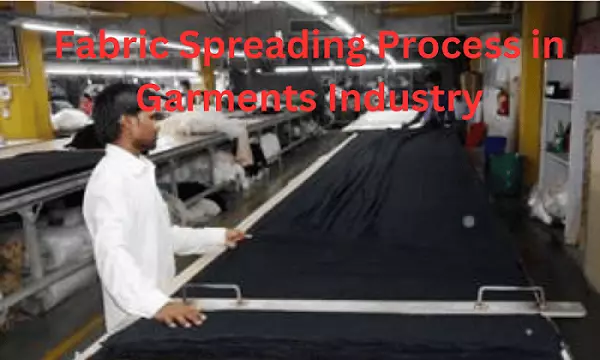Spreading means the smooth laying out of the fabric in a superimposed layer of a specified length. The cutting marker is laid on the topmost layers. The maximum width of the cutting marker is constrained by the usable width of the fabric. Fabric spreading is a very important process in the cutting section of the Garments Industry in order to get a correct measurement and good quality of finished garments. Spreading is nothing, just laying fabrics on the cutting table. In the Cutting Department, the previous process of fabric spreading is the Fabric relaxation process.
Fabric spreading means spreading the fabric in a systematic manner. The fabric is stretched to get the length and width of the marker paper. This is the previous step in the cutting process. But while spreading the fabric, care should be taken that the number of fabrics in the fabric pile is less than 300. The thickness of the fabric and the height of the knife i.e. the edge of the knife will depend on how much fabric can be taken i.e. how many fabrics can be cut together. Ply height and plies number depend based on the fabric type cutting, 180 plies can be for woven fabric, and 90 could be for denim fabric.

Objects of Fabric Spreading:
- The objects of fabric spreading are to place the number of plies of fabric to the length of the marker plan correctly aligned as to length and width, without tension.
- To cut fabric in proper tension so that cut fabric shape and dimension remain the same after cutting
- To cut garments in bulk and save in fabric using multi garments marker plans and the saving in putting time per garment that results from cutting many plies at a time.
- To make every ply plain and flat.
- To save time by cutting many layers of fabric at a time.
- Measurement control for stretch and other fabric.
Types and Methods of Fabric Spreading Process
Types of Spreading:
- 1) Flat spreading: Many fabrics of the same length are arranged one on top of the other.
- 2) Stepped spreading: Many fabrics of the same length are arranged one on top of the other in different steps.
Methods of Spreading Process
Manual Method:
- By hand: Two workers spread the roll of fabric on a table based on the length and width of the marker paper.
- By hook: In this method, the edge of the table on which the cloth is to be spread is kept at an angle of 10 degrees. The hook placed on the edge on the table is 15 cm long and the hook is attached to one end of the fabric selvage. The fabric selvage is spread on the table by checking the fabric. After spreading the fabric, the edge is set back on the table and the marker paper is placed on the stack of fabric.
- Spreading truck with the help of the operator: At one end of the table there is a spreading truck with the help of which the fabric roll is placed. The truck is moved by hand from one end of the table to the other and at the same time, the fabric from the roll is spread lengthwise and widthwise on the table.
Mechanical method
Semi-Automatic: There are two rails at both ends of the table over which the spreading machine is moved from one end to the other. With the help of electrical and mechanical motion, the spreading machine is moved from one end to the other resulting in a stack of cloth.
Semi-Automatic Spreading Machine:
- Advantages of semi-automatic spreading:
- Maximum speed 100m/min.
- Fabric defects can be identified.
- Maximum height can be kept up to 25 cm. Fabric roll weight can be kept at 80-675 kg.
Disadvantages of semiautomatic spreading:
- Considerable time is required.
- Labor wages are high.
- Spreading cannot be done on any type of fabric.
Full automatic: This is an advanced step of the semi-automatic machine. It is controlled by robots and microprocessors.
- Advantages of automatic spreading:
- Less time is required.
- Spreading is possible on any type of fabric.
- Labor wages are low.
- Disadvantages of automatic spreading:
- This is a very expensive process.
- A skilled operator is required to control the machine.
- You may love to read: Flow Chart of Garments Fabric Cutting Room
